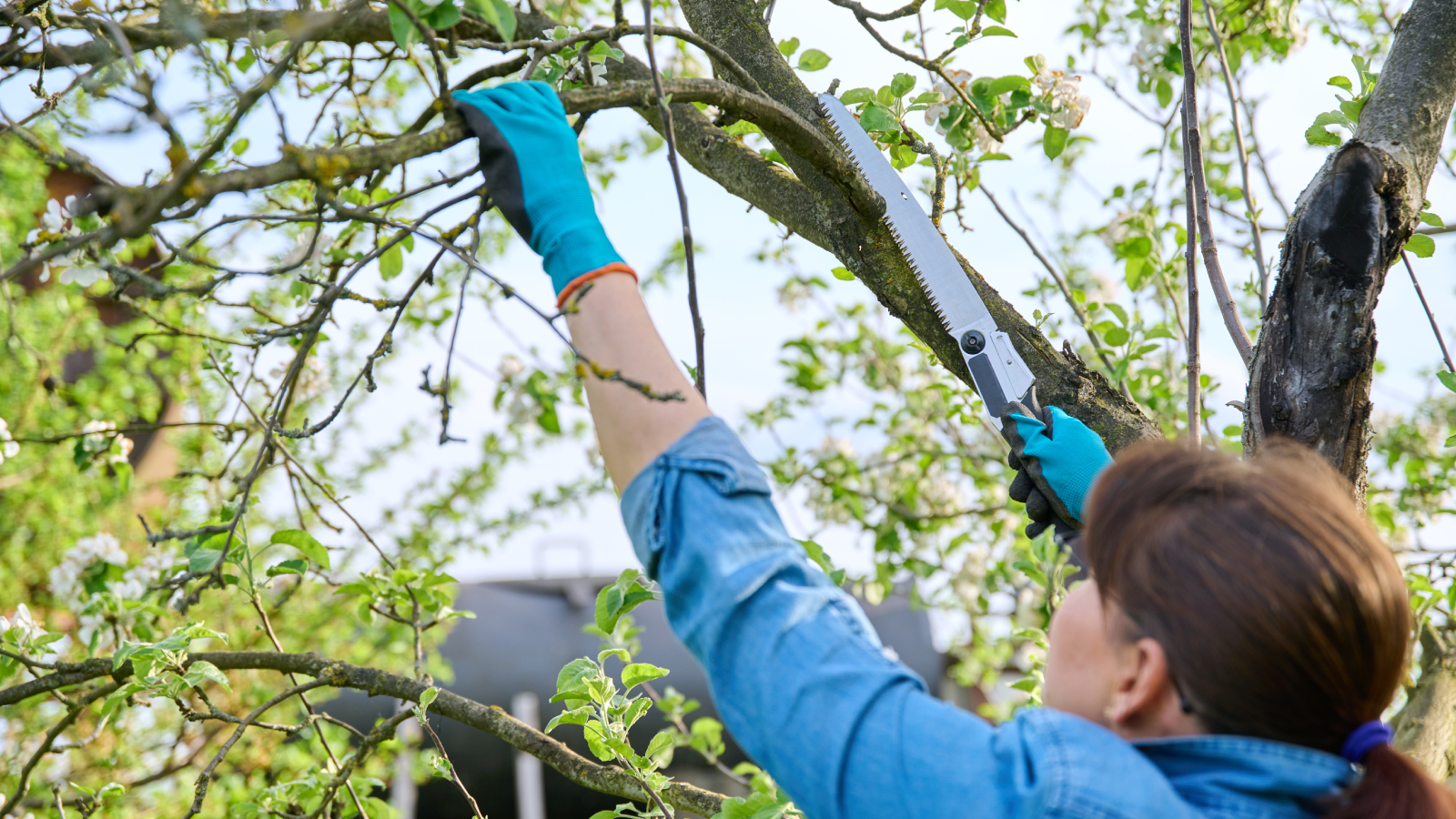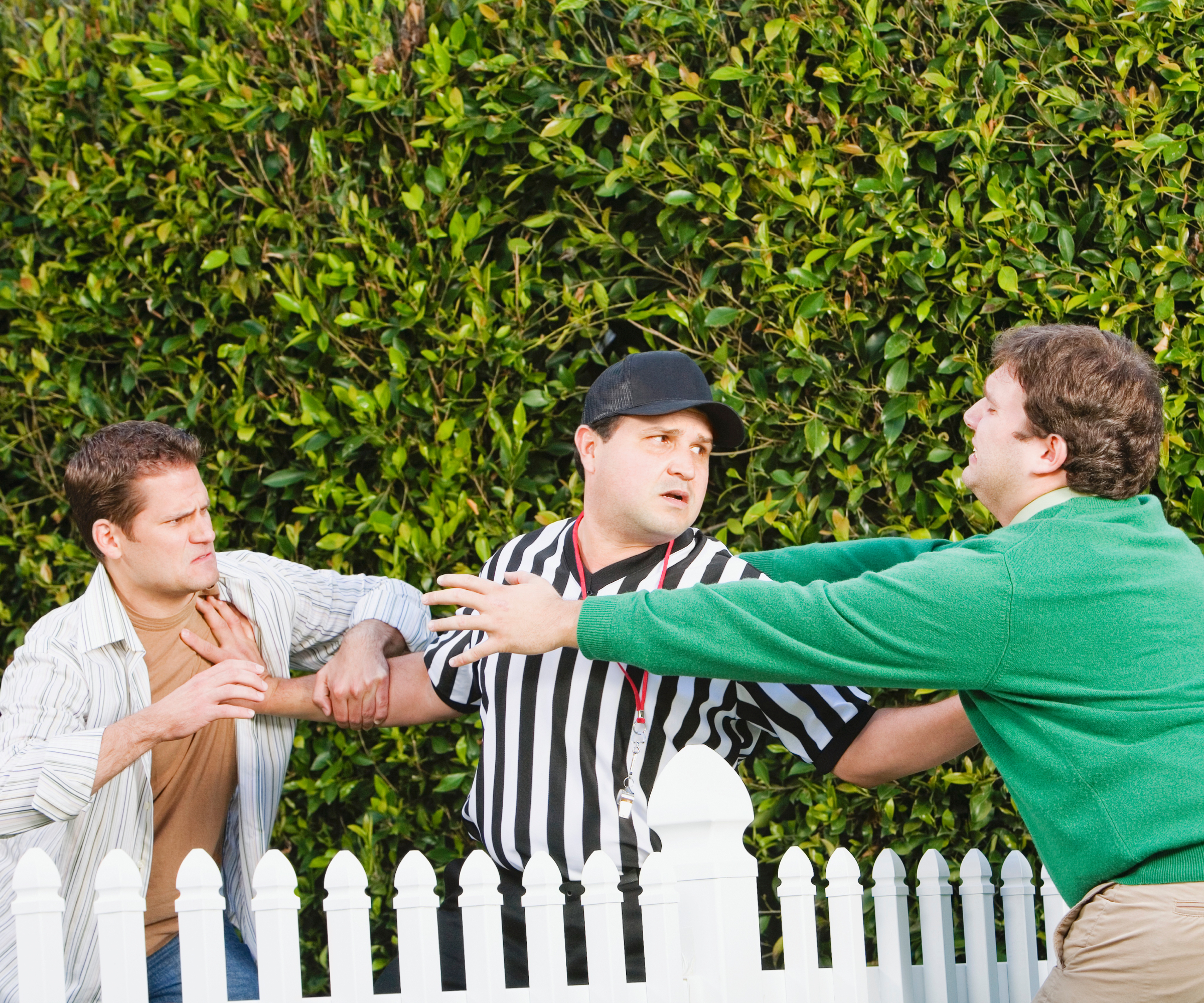Is your neighbour's tree blocking sunlight? Here's what you can and can't do when it comes to trimming trees that aren't your own
Tackling your neighbour over a troublesome tree casting shade over your home or garden needn’t be daunting or lead to a dispute if you follow our expert advice

Tree-related issues, from annoying overhanging branches to severe impact on sunlight coming into your home, are a common source of neighbour disputes.
There’s no general maximum height or spread for individual garden trees in UK law. So when a tree starts blocking natural light, this can lead to trouble. The general rule is that you’re allowed to trim any branches which overhang the boundary, informing your neighbour politely of your intention.
However, if the tree is especially tall or broad, you’re going to have to talk to next-door about how to proceed. We explore the potential issues, explain why you can't generally use the right to light ruling, and what a dispute could entail if the neighbourly love doesn't prevail.
How to approach a troublesome tree with your neighbour
The best first step to take when a tree is obstructing light to your home or garden, is to approach your neighbour amicably.
“Most of the time, this issue can be resolved with a polite, face-to-face conversation,” says Toby Leek, NAEA Propertymark president. “People can be very understanding in situations like this, and it is crucial to exercise patience too, as they have commitments that may stop them from taking action immediately.”
The key, says Dean Meadows, principal arboriculturist at ecological and arboricultural consultancy, Arbtech, is to avoid treating the issue as a legal dispute in the first place. “Instead, open up a friendly dialogue to discuss the matter, raise your concerns, and propose an arboriculturally-sound course of works to address the problem, such as judicious pruning.”
You may also wish to ask an arboricultural expert for initial advice, check for Tree Preservation Orders (TPOs) and, if you’re in a conservation area, any restrictions. If any statutory protection applies, written consent from the local planning authority will be needed – even for minor works.
Bring your dream home to life with expert advice, how to guides and design inspiration. Sign up for our newsletter and get two free tickets to a Homebuilding & Renovating Show near you.


Toby Leek is president of NAEA Propertymark, a national regulatory membership body for estate agents. He is also a sales manager for Laurent Residential, with a history of working in the property industry across central London and Surrey.

Dean Meadows is a principal arboriculturist and tree risk lead at leading UK ecology consultancy Arbtech, with more than 10 years’ experience in arboriculture and tree risk management. Dean’s expertise in undertaking large to small-scale tree risk and condition surveys sees him collaborating with organisations, landowners and local authorities. In 2020, Dean was named as one of Pro Landscaper’s 30 Under 30: The Next Generation, an award recognising exemplary young, aspiring, and ambitious professionals.
What if your neighbour refuses permission to trim the tree?
In such a situation you should explain calmly how the tree is affecting your enjoyment of your home, says Toby Leek, “whether it’s overshadowing a garden, blocking light into a key room, or causing maintenance issues such as falling leaves or debris.”
You are allowed to trim back any branches that cross over your boundary without needing your neighbour’s permission, so long as you do not go beyond the boundary line. However, it's always best practice to inform your neighbour before carrying out any work. You should ask them if they would like the clippings returned, although in most cases people dispose of the waste themselves.
“You still have a common law right of ‘abatement’ to prune branches and roots that cross the boundary back to the boundary line, but no further, provided you do not trespass or damage the tree,” Dean Meadows stresses. “If more drastic height reduction is needed to abate the issue, try formal mediation before going to court.”
A specialist independent panel, such as the RICS Neighbour Disputes Service, is the most appropriate mediator to approach for such cases. Mediation is consensual. “You invite, not compel,” says Dean. “You can send a ‘CPR Pre-Action Letter’ offering mediation. If your neighbour refuses unreasonably and you later win in court, a judge can penalise them for costs.”
The RICS Neighbour Disputes Service operates in three stages. One or more can be used to resolve the dispute and cost as follows:
- Stage 1: Expert Evaluation - £2,400 +VAT
- Stage 2: Negotiation and Compromise - Stage 1 & 2 - £2,950 +VAT
- Stage 3: Expert Witness Reporting - Stages 1, 2 & 3 - £3,500 + VAT
Should you do the job yourself?
Trimming off odd minor branches yourself shouldn’t harm the tree, but before you get the clippers out, always look up the species and recommended pruning times of year. If you're dealing with a tree, take a look at the advice for cutting down a tree (although it's of course not advisable to cut the whole tree down), but be sure also to follow expert recommendations on when to cut hedges to avoid getting into trouble.
Toby Leek says for anything more than a trim, find a proper tree surgeon. “They will understand how much can safely be cut without harming the tree and will also be able to check for any Tree Preservation Orders (TPOs) or other legal restrictions before proceeding.”
If you damage the tree it could be considered negligent and you may face legal action from your neighbour. “Therefore, it is important to employ a competent, insured Arboricultural Association Approved Contractor working to BS 3998 and/or an arboriculturist to maintain a suitable specification,” says Dean Meadows.
Can you insist your neighbours pay for the work?
The default presumption is that you pay. “The tree owner owes no duty to subsidise unless a court or council finds the tree a legal nuisance,” Dean Meadows explains. “Where a hedge breaches the High Hedges rules, a local authority's remedial notice can compel the owner to cut at their cost. Otherwise, cost-sharing is purely by agreement.”
What’s the ‘right to light’ legislation?
Natural light to your property is protected under the Rights of Light Act 1959. The law recognises a legally enforceable 'right to light', if a window or opening has enjoyed unobstructed daylight for at least 20 years.
Dean explains: “Once established, this right continues even if something later appears, such as newly-planted trees, that begin to block the light.”
However, ‘right to light’ when it comes to trees is a difficult matter to prove. Case law shows claims against trees rarely succeed, as the test is typically asserted against buildings, Dean warns.
Should you wish to proceed in obtaining evidence, loss of light may be assessed by a specialist survey using the Waldram method. This evaluates the amount of light received directly from the sky in a room, typically at table height.
A room is considered to enjoy 'sufficient light' if it has a daylight factor of ≥ 0.2 per cent over at least 50 per cent of the floor area.
“Anything below this threshold triggers potential compensation under the Rights of Light Act 1959," explains Dean, "because courts compare today’s light with the notional 20-year baseline, consultants model the ‘then’ scenario from old photos, solar data, or other records.”

Does 'right to light' apply to gardens?
The 'right to light' legislation protects only habitable interior rooms, advises Dean Meadows.
“Gardens and patios enjoy no statutory 'right to light'. However, severe overshadowing by vegetation can still be pursued as a common law nuisance or under the High Hedges regime Part 8 of the Anti-social Behaviour Act 2003.”
What’s the difference between laws for trees and laws for hedges?
When it comes to the legal height of a hedge between neighbours, hedges that are evergreen or semi-evergreen, in a row of two or more stems, and over two metres tall fall within Part 8 of the Anti-social Behaviour Act [ABA] 2003. In this case, the local council can issue a remedial notice forcing height reduction. However, there is no equivalent statutory cap for single trees.
For the ABA to apply there has to be what’s known as a ‘high hedge’, says David Shakesby, director in the property litigation team at national law firm Freeths. “This can be a line of trees, but not a single tree. Gaps, or trees of different heights will be taken into account.”
Other factors considered include whether the high hedges entirely block or just interfere with light, if the foliage is evergreen – so the situation remains the same year-round – or if there’s a difference in light coming through at different times of year.

What happens if you kill or damage the tree as a result of pruning?
So your neighbour has given you permission to trim the tree, but as a result it suffers disease or even dies. What next?
“Even with your neighbour’s permission, if you carry out the work yourself or instruct someone else to do it and the tree is damaged, becomes diseased, or dies as a result, you could be held liable for the damage,” warns Toby Leek.
“This includes being responsible for the cost of replacing the tree or compensating your neighbour for the loss.”
FAQs
Do you have to declare any tree-related disputes should you sell your home?
“Absolutely - yes, you must declare all disputes, including those related to trees, when selling your property,” says conveyancing expert Stuart Forsdike, founding partner at PCS Legal.
When selling, you are legally required to complete a Property Information Form (TA6), which forms part of the conveyancing process. “One of the key sections in this document asks whether there have been any disputes or complaints with neighbours,” says Stuart.
“This is not limited to formal legal disputes, it also includes informal or ongoing disagreements, for example, arguments over a tree blocking light, dropping debris, or causing damage to fences or structures.”
It is important to understand that a “dispute” does not have to end in court to be considered legally disclosable. Even if the dispute has been resolved, it should be disclosed, along with details of how it was settled.
“If there has been a written exchange, a formal complaint to the council, or even repeated verbal disagreements that show an ongoing issue, these must be disclosed,” Stuart adds. “Failing to do so could result in the buyer pursuing legal action after the sale, potentially seeking financial compensation or even rescinding the purchase.”

Stuart has more than 28 years’ conveyancing experience, as qualified licensed conveyancer, specialising in residential and commercial conveyancing, and wills and probate. Winning multiple industry awards, he is a senior partner at PCS Legal, one of the largest firms of licensed conveyancers in the UK, regularly ranked in the top 40 law firms dealing with volume conveyancing based on land registry statistics.
Know your rights when it comes to neighbouring trees overshadowing your property and you should be able to resolve any issues without recourse to legal action.
On the other hand, if you're looking at a plot to buy that's close to neighbours with large trees, as well as understanding how daylighting will need to be carefully considered in your design, make sure you understand the implications of building by trees before you sign on the dotted line.
